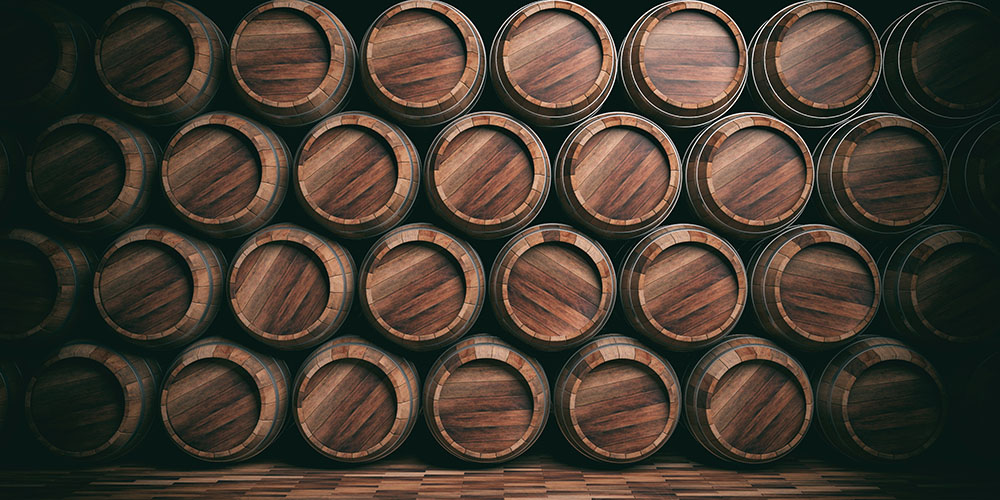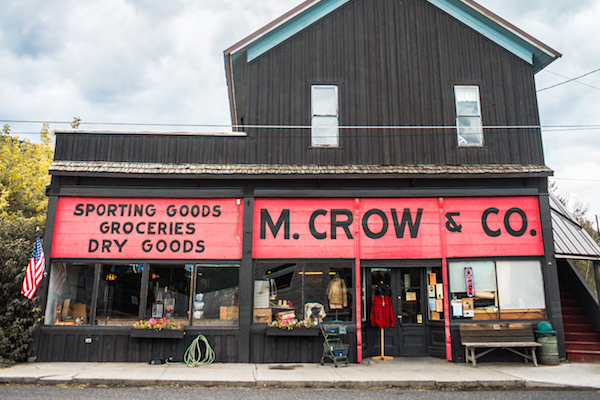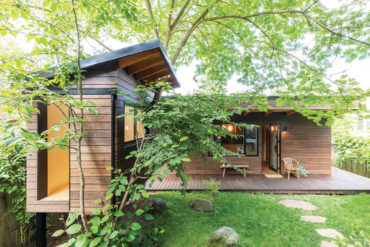Has Oregon’s beer industry jumped the shark?
written by Sheila G. Miller
I was in the Portland International Airport the first time I saw it—beer dedicated to the memory of the PDX carpet. Then I saw one inspired by Voodoo Doughnut flavors. I was lost.
I grew up in Portland in the days when the microbrew of choice was Henry Weinhard’s. Sure, that was when the beer was still brewed in the Pearl District and the Pearl was not called that—it was just a bunch of warehouses, factories, the brewery and Powell’s. I digress, but only to explain that a lot about Oregon has changed in the past couple decades, and nowhere is that more apparent than in the beer scene.
From these humble beginnings we have arrived at a crossroads—as of the end of 2016, Oregon now has at least 230 brewing companies statewide, according to the Oregon Brewers Guild. Today you can fill a growler with one of thirty craft brews at a gas station, or cycle-power a boat along the Willamette River while drinking your choice of craft beers. You can eat a burger made from cows that were fed the spent grain from the local beermaking process, and soak in a beer spa.
So where does Oregon’s beer scene go from here? Have we reached peak beer?
The facts about Oregon beer
First, the facts. According to records from the OLCC, as of May 2017 (the most recent data available) breweries and brewpubs in Oregon had sold almost 247,000 barrels of beer and cider. A barrel is the equivalent of 31 gallons. If I’m doing that math right, and OLCC tells me I am, 7.5 million gallons of beer and cider were sold in the first four months of the year.
That’s a lot of beer. At the end of 2016, Oregon breweries and brewpubs had sold more than 625,000 barrels—more than 19 million gallons. That’s everyone from Deschutes and Ninkasi, which are consistent top sellers, to places like Wm. Roesch Brewery in Pendleton, which reported selling 0.17 barrels in April.
Oregon ranked fourth in the number of gallons of beer brewed annually per adult older than 21, according to the Brewers Association, a national nonprofit trade organization—only Alaska, Colorado and Pennsylvania rank ahead. That’s nearly 12 gallons per legal drinker.
Damon Runberg, a state economist based in Bend, sees a slight slowdown in the growth of the beer industry in Oregon. But the industry continues to grow at a fast clip. A net gain of twelve breweries between 2015 and 2016, an increase of more than 500 employees in those years, 8 percent—this is growth nearly any industry would love to have. But it’s a far cry from previous years—for example, between 2014 and 2015 the growth rate was more than 13 percent.
The state is now seeing some closures—fourteen breweries closed in 2016. Nonetheless, breweries continue to be a place for Oregonians to seek work—more than 6,700 men and women now work in breweries around the state, and the total payroll is almost $204 million.
Peak beer in Oregon
“There is a growing belief that Oregon reached ‘peak beer,’ meaning the current supply of breweries is sufficient to meet the current (and short-term future) demand,” Runberg wrote in a recent report. “However, the industry continues to grow, albeit at a slower pace. It would be hard to make a case that the brewing industry peaked when employment in that sector expanded by 8 percent in the past year.”
Runberg divides the brewing industry into two markets—pubs and distribution. It’s in that distribution channel where there’s still a lot of room for growth. Bend’s Deschutes Brewery, for example, distributes in twenty-eight states and is in the midst of building a tap room and then, a brewery and distribution center in Roanoke, Virginia. 10 Barrel, which was purchased by Anheuser-Busch in 2014, to some disdain, now has new distribution channels and money to build out new facilities.
“Most states don’t have the saturation that Oregon does,” Runberg said, which means Oregon’s breweries have more opportunity in larger markets outside of Oregon.
While seeing breweries closing in their communities might lead consumers to think the beer industry has stopped growing, Runberg said.
“Very few brewers are saying that there wasn’t demand for their product,” Runberg said. “What a lot of them said was, ‘This was a side gig and it’s become a full-time job.’ They’d started home brewing and it had gotten overwhelming. Their bandwidth ran out. But I’m not hearing that nobody bought their beer.”
He also noted that the beer industry does not follow the same trends as the rest of the economy when recession hits.
“In slow times, people still drink beer.”
Nonetheless Runberg highlighted an opportunity for diversity in the brewing industry—not every brewery needs to make one IPA, one porter, one stout and so on. He pointed to Monkless, a Bend brewery that focuses entirely on Belgian ales.
He also pointed out most breweries follow the same path when seeking success and expansion—opening a pub and then expanding brewing to match demand. Runberg until recently used Boneyard Beer in Bend as an example of a brewery that hasn’t followed that traditional path. Boneyard is only now in the process of opening a pub, seven years after it started selling its beer to bars and restaurants around the state and operating a tiny tasting room in what looks like an old autoshop.
Tony Lawrence started Boneyard Beer in 2010 with two cofounders, no outside investors and a belief that making great beer would sustain the company. He was right.
Lawrence said the key to Boneyard’s success was creating a high-quality product and making good business decisions.
“I think you will see a lot of these people not be able to produce a high-quality product or make terrible business decisions along the way—mostly from a capital standpoint,” he said. “A lot of these new breweries seem to be using a bunch of cash that they haven’t really earned, based off twenty-four-month statistics of growth, and they’re going to get into a pinch, in my opinion. If there is some type of shakeout, some will make bad decisions in a crowded marketplace. They could make them in a lesser marketplace and survive, but I think there will be a natural (purge).”
Lawrence believes there will always be room for a small brewery with a neighborhood pub that makes good food and beer and understands its regulars. But trying to distribute that beer at a high volume probably won’t get any easier.
“It’s definitely getting more difficult to hook up with a distributor,” Lawrence said. “We’re seeing distributors slowing down on acquiring brands, because it’s too much work anymore to keep everybody happy.”
“I think there’s room—if you make a high-quality liquid and make good decisions and you don’t get too upside down financially, you can hang on.” Ninkasi CEO Cheryl Collins agreed. “At the end of the day, it’s all about the quality and drinkability of the beer.”
Beer first approach
While his wasn’t the traditional approach, Lawrence said he started Boneyard without a pub because it was what he understood. He’d primarily worked in production-based breweries, not in restaurant or bar management.
“That, coupled with a lack of money I had, I thought I better focus on what I know how to do,” Lawrence said. The brewery will open a pub in Bend this summer or fall. “Here we are, seven years later, and we’ve made a couple dollars and the tourism scene in Bend and elsewhere is so thriving, it seemed the right time.”
Nothing screams “peak beer” like the influx of crazy flavors such as strawberry cheesecake stouts and peanut butter porters. Heck, you can even find recipes for beer slushies these days.
“Those beers may have a moment in the evening or the week,” Lawrence said. “But we’ve had luck with a repeatable, sustainable clean IPA on the table, and I think fortunately people want to buy two or three of them. We’re old-school brewers. We like pilsners and hoppy beers and sours. That’s a diverse platform but those are all original styles. And Boneyard is still about that.”
“I think breweries are doing that to give themselves the opportunity for placement on the shelf or a tap handle,” Lawrence said. “They’re doing a lot of things that I don’t want to do, but they’re probably forced into. … It’s helping some of the younger brands find an opportunity for themselves.”
Collins said there’s no question the brewing industry can continue to grow. “It’s less about if we, as an industry, can grow and more about how we are approaching growth,” she said. “As with any industry, when you have this many players in the market, the need to become more creative and innovative is required to stay at the top of consumers’ minds.”
While the brewing industry may be changing and slowing, businesses that take advantage of Oregon’s beer tourism and reputation are booming. In many cities around the state, tour companies will organize brewery tours and beer tastings—leave the driving up to them. That’s just the start.
Andrea Lins runs BrewGroup, a company that offers pub crawls with its Beer Cycle and Beer Barge throughout Portland. Lins is originally from Wisconsin, and she moved to Portland sight unseen to start the beer-adjacent company in 2012.
“We picked Portland because everyone can go on a pub crawl and get a rum and Coke, or in Wisconsin, where I’m from, a Miller Lite. But I loved the idea of being part of something a little bit more local,” she said. “Here you can go on a pub crawl and get a beer from a place that is brewing it in the back room.”
Oregon beer tourism
With the Brew Cycle, you and your fourteen closest friends can cycle on a giant moving bar through the Pearl District on a two-hour pub crawl that hits three breweries and pubs. Or hit the high seas with the Brew Barge, a ninety-minute pedal on the water. Bring your own beer, wine or cider.
Considering how quickly Lins’ company has grown, she thinks there’s continued room for growth in the brewing industry in Oregon. In fact, she and her brother recently opened a nanobrewery—Back Pedal Brewing.
“This is a generation that is putting more money into experiences,” she said. “We aren’t the generation who owns a lot. Things can be rented. So I think that a lot more of the disposable income is going into experiences like we offer.”
The number of breweries and beer-related companies in Oregon doesn’t mean the end is nigh. “It’s not about the competition per se,” she said. “It’s more about the innovation and the community aspect of the brewery industry.”
Lins said beer consumers will continue to seek new experiences, and that pubs and breweries can keep patrons with new experiences and new beer.
Back Pedal Brewing in Portland is a three-and-a-half-barrel system nanobrewery that’s been brewing for two years. Recently Back Pedal brewed a lemon rose beer, using fruit puree. “We’re just having a lot of fun with different ingredients and different combinations, so we’re lucky to be such a small-batch brewer because we can be extremely experimental,” Lins said.
“I think that more capacity would allow us to have a wider range,” Lins said. “We’re running out of our beer too fast.”
[su_panel]
Oregon Beer Statistics
Breweries and brewpubs sold more than 625,000 barrels (19 million gallons) of beer In 2016.
Oregon is ranked fourth in gallons of beer brewed annually per adult—nearly 12 gallons per year for every legal drinker.
More than 6,700 men and women now work in breweries around the state with an annual payroll of almost $204 million.
[/su_panel]









